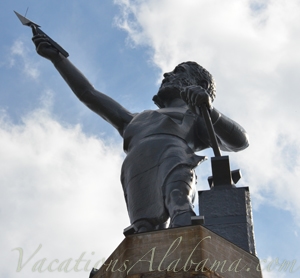1701 Valley View Drive Birmingham, AL 35209
Standing 56-foot (17 m) tall and weighing 50-ton Vulcan is the worlds largest cast iron statue. Vulcan is the god of the fire and forge and stands on a 124-foot pedestal. He was designed by Italian sculptor Giuseppe Moretti and made for the 1904 World's Fair in St. Louis, Missouri. He was moved to Birmingham in 1936 and has been used for advertising items. Now he sits high up Red Mountain towering above downtown Birmingham in Vulcan Park.
Gift Shop, Overlook, Seasonal Concerts, Museum, Ride the elevator to the top of Vulcan and experience an awesome view of Downtown BIrmingham
Museum:
Mon - Sat 10 am - 6 pm;
Sun 1 - 6 pm
Observation Tower:
Mon - Sat 10 am - 10 pm;
Sun 1 - 10 pm
The Vulcan statue is a famous landmark located in Birmingham, Alabama. The statue is the largest cast iron statue in the world and is considered one of the most significant works of art in Alabama. The statue stands tall at 56 feet and weighs over 100,000 pounds. Vulcan is a symbol of the city’s industrial heritage and is an important cultural and historical icon for the people of Birmingham.
The statue was created by Italian artist Giuseppe Moretti in 1904 and was originally meant for the 1904 St. Louis World’s Fair. However, Birmingham residents wanted the statue to be a permanent fixture in their city, so they raised funds to purchase it. The statue was reassembled in Birmingham and has since been an important part of the city’s skyline.
Vulcan is a Roman god of fire and metalworking, making it an appropriate symbol for Birmingham, which was once known as the “Pittsburgh of the South” due to its iron and steel production. The statue’s raised arm holds a torch, which has been a symbol of enlightenment and progress since ancient times. The statue was designed to represent the city’s industrial progress and the potential of the South as a region for manufacturing and industry.
In addition to its artistic and cultural significance, the Vulcan statue also serves as a popular tourist attraction. Visitors can climb to the top of the statue and enjoy panoramic views of the city. The park surrounding the statue is also a popular spot for picnics and outdoor events.
The Vulcan statue has undergone several renovations over the years to ensure its longevity. In 1999, the statue underwent a massive renovation that included the installation of a new observation deck, a museum, and an educational center. The renovation project was funded by private donations and grants, and it helped to ensure that the statue remains an important part of Birmingham’s history and culture.
In conclusion, the Vulcan statue is a remarkable work of art that represents the history and culture of Birmingham, Alabama. The statue is a symbol of the city’s industrial heritage and serves as a reminder of the potential of the South as a region for manufacturing and industry. The statue’s artistic and cultural significance, combined with its popularity as a tourist attraction, make it an important landmark for the people of Birmingham and visitors alike. The Vulcan statue is a testament to the city’s rich history and serves as a source of pride for the people of Birmingham.

